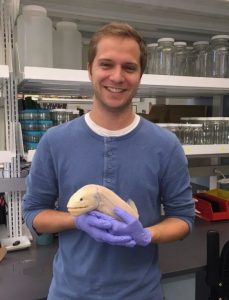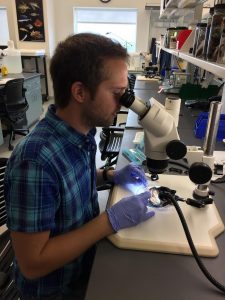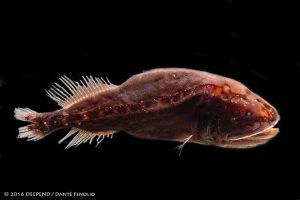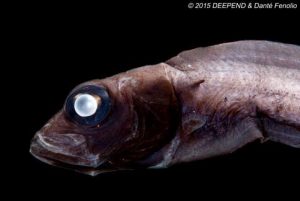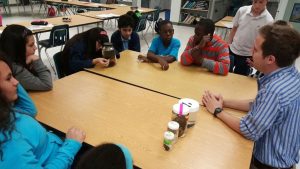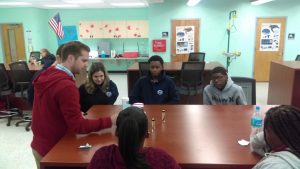Grad Student Novotny Searches for Oil Transport Pathways in Deep-Sea Fish Stomachs
– May 2, 2017
The high cost and small catch sizes associated with deep-sea research often limits scientists’ ability to study many deep-pelagic species. Mike Novotny examines the stomach contents of various bathypelagic fishes to better understand their feeding habits and collect valuable data that can help identify potential transport pathways for oil, carbon, and nutrients in the Gulf of Mexico water column.
Mike is a master’s student in Nova Southeastern University’s marine environmental science program and a GoMRI Scholar with the Deep-Pelagic Nekton Dynamics of the Gulf of Mexico (DEEPEND) consortium.
His Path
Mike became interested in aquatic science after winning a goldfish at a summer carnival when he was eight years old. It was his first pet, and he has been fascinated with fish ever since. Growing up in Illinois, his family’s Florida vacations introduced him to the coastal environment, and a trip to the Bahamas further fueled his love for the ocean. He completed a double undergraduate degree in biology and marine science and a minor in chemistry at the University of Tampa in 2012.
Mike read several journal articles by Tracey Sutton, a marine and environmental sciences professor at Nova Southeastern University, while researching graduate schools. Interested in working with him, Mike enrolled in Sutton’s ichthyology class and volunteered in his lab. He joined Sutton’s DEEPEND project as a graduate student conducting a deep-sea trophic analysis. “I knew immediately that this was going to be an incredible experience,” said Mike. “Every day, I work with fishes that most people don’t know exist and that other marine biologists rarely get to see.”
His Work
Mike conducts novel research characterizing the diets of bathypelagic (greater than 1000 m depth) fishes. He wants to know if they feed mainly within the bathypelagic zone, as the current literature alleges, or if they also consume organisms farther up the water column. Because many organisms from higher trophic levels experienced significant oil exposure following Deepwater Horizon, they could represent a significant pathway for oil to enter and potentially impact the deep-sea ecosystem. “The bathypelagic biome is the world’s largest. If bathypelagic organisms are affected by oil, it could lead to some drastic alterations in the way carbon moves through the deep sea,” he said.
Mike dissects fish’s intestinal tracts and reviews their stomach contents under a microscope. He looks for recognizable structures such as fish eye lenses, squid beaks, bone fragments, and photophores that will help identify which organisms the fish was preying on. “It’s like putting a puzzle together. You have bits and pieces in the stomach, and you’re trying to figure out what the rest of the picture is,” he explained. He considers these observations alongside the fish’s size class to determine if their desired prey changes across size ranges. Because a fish’s size is indicative of its age, these observations could indicate ontogenetic shifts in diet.
His Learning
A summer 2016 research cruise is one of Mike’s fondest memories with the consortium. “Being surrounded by top researchers, watching what they do best, and being part of cutting-edge research and exploration was a dream come true and a checkmark off my bucket list,” he said. “It has been such an honor being part of DEEPEND and assisting with the incredible research.” He explained that participating in a large consortium like DEEPEND has allowed him to meet many researchers with unique stories and paths. Their experiences have shown him that there are many different opportunities and careers he could pursue in the future.
His Future
Mike plans to complete his master’s degree and work in the South Florida area as an environmental consultant. Environmental consultants survey areas being considered for future construction and assess if the land is acceptable to use and how to mitigate environmental harm the construction could cause. “Working with the oil spill showed me that there were very few, if any, surveys done in the spill area. It made me wonder if conducting a proper survey before they constructed the well could have lessened the spill’s impact,” he said. “Environmental consulting is a great hybrid of the three things I’m passionate about: outreach, communication, and research.”
Mike advises that students considering a career in science keep an open mind to new experiences and try different opportunities as they arise. “You might think you’re really into studying a certain organism, but give other organisms a chance – they might speak to you in a completely different way,” he said.
Praise for Mike
Dr. Sutton described Mike as an excellent student and “fantastic person who is a joy to be around.” He particularly praised Mike’s outstanding work in the Nova Southeastern University Oceanic Ecology Lab. “I strive to have a high-functioning lab that is also a fun workplace, and having people like Mike is the key,” he said. “His position as sample processing manager comes with a great deal of responsibility, as nearly every DEEPEND project relies on cruise samples and their associated data. My trust in Mike relieves a great deal of pressure – I am lucky to have him.”
The GoMRI community embraces bright and dedicated students like Mike Novotny and their important contributions. The GoMRI Scholars Program recognizes graduate students whose work focuses on GoMRI-funded projects and builds community for the next generation of ocean science professionals. Visit the DEEPEND website to learn more about their work.
***********
The Gulf of Mexico Research Initiative (GoMRI) is a 10-year independent research program established to study the effect, and the potential associated impact, of hydrocarbon releases on the environment and public health, as well as to develop improved spill mitigation, oil detection, characterization and remediation technologies. An independent and academic 20-member Research Board makes the funding and research direction decisions to ensure the intellectual quality, effectiveness and academic independence of the GoMRI research. All research data, findings and publications will be made publicly available. The program was established through a $500 million financial commitment from BP. For more information, visit https://gulfresearchinitiative.org/.
© Copyright 2010- 2017 Gulf of Mexico Research Initiative (GoMRI) – All Rights Reserved. Redistribution is encouraged with acknowledgement to the Gulf of Mexico Research Initiative (GoMRI). Please credit images and/or videos as done in each article. Questions? Contact web-content editor Nilde “Maggie” Dannreuther, Northern Gulf Institute, Mississippi State University (maggied@ngi.msstate.edu).

